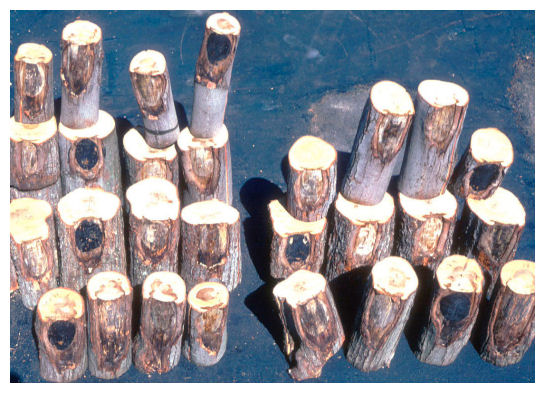


We should not rely on medicines and wound dressings to correct problems we create. It is not so important to start new practices as it is to STOP many old practices that do more harm than good.
Microorganisms have their picnics and parties under wound dressings.
Words From SHIGO on Wound Dressing
It is the wound dressing idea more than the material that is dangerous. "Don't worry, do want you want to the tree and paint it black and it is a forgiveness of sin." The tree system just not function that way.
Research Data - 13 Years Of Studies
Most wounds do not lead to decayed wood or hollows.
Some Photos Of Interest 1 of 2
Heartrot and wound dressings are twins.
Some Photos Of Interest 2 of 3
Wounds are mechanical disruptions that alter the high order of an organism, thus causing injury.
The wound dressing myth will never die. The sad thing is that the myth is being taught by people who are supposed to be scientists.
How will we ever get to the excitement of electromagnetic fields when the same old stuff is still being taught: heartrot, wound dressings, plant food, and all types of cure-alls.
Major Myths - Wood is dead. Heartrot explains decay. Flush cuts are correct. Wound dressings stop rot. Nature is balanced. Fertilizer is food. Wetwood is bad. Planting deeply is good. Rot is a major cause of failure. Water causes decay. Insects and diseases are the major causes of tree problems. Mulch belongs on the trunk flair. There are at least a hundred more.
Old arboriculture was based on three treatments: cutting branches flush to the stem, painting wounds, and fil1ing cavities. Spraying came later.
Wound Dressings
Wound dressings take us back to confusion between trees and people again.
When you were a child, your mother put some medicine on your cuts and bruises.
If you love trees, you should also put some medicine on their cuts and bruises.
A well painted wound has been the hallmark of the arborists for
centuries. Flush cut and paint have been the recommendations for
centuries.
Wound dressings will never go away. The search for a magic medicine to
stop rot and to undo all the injurious treatments inflicted on trees by man will
continue. The major problem in this entire area is the lack of
understanding about trees. Once a person begins to understand how trees
are constructed, and how trees respond to wounds, it will be clear to them that
wound dressings may hurt more than help the tree.
Wound dressings have been with the tree business in cities, forests, and
orchards for many centuries. There were awards given for the
best concoctions. Many of the ingredients used are not "nice" to write
about. The driving force was to find a material that would block the infection
by pathogens. Some other materials were used because they kept the
cambium moist, or helped to dry the wound surface, or to kill the pathogens, or
to stimulate callus formation, or to keep insects out that carried pathogens, or
to keep everything out but to let the wound "breath." Everybody
wants to make the perfect dressing, but few people have designed experiments with controls
to test their product. Now comes the callus healing confusion again. Many
materials will stimulate callus formation. Well! Is this not a stimulation of
the healing process? The confusion over basics of tree biology strike again. Callus formation is easy to measure. It is difficult to cut and dissect trees.
Then there are those who say that wound dressings are needed to keep out insects that carry pathogens. These people prune when leaves are forming. This is the natural high period for infection. Flush cuts are also made. So, two serious mistakes are made and now a medicine to undo these mistakes is wanted. Also, there is a difference between dissemination of a pathogen - to carry it from place to place - and transmission of a disease - taking the pathogen to an infection court and having infection occur. My old professor, Dr. J. G. Leach wrote the book on insect transmission of plant diseases. This point he stressed over and over again. People are still missing his point. If branches are pruned properly, and if a pathogen could infect, only a small strip of tissue on the trunk below the branch would be infected (see chapter on branches in "A NEW TREE BIOLOGY").
Of the hundreds of papers and claims about wound dressing, only a few include experiments with controls and dissections.